
Suchomimus is a genus of spinosaur dinosaur that lived between 125 and 112 million years ago in what is now Niger, north Africa, during the Aptian to early Albian stages of the Early Cretaceous period. It was named and described by paleontologist Paul Sereno and colleagues in 1998, based on a partial skeleton from the Elrhaz Formation. Suchomimus's long and shallow skull, similar to that of a crocodile, earns it its generic name, while the specific name Suchomimus tenerensis alludes to the locality of its first remains, the Ténéré Dese.

Cristatusaurus is a genus of theropod dinosaur that lived during the Early Cretaceous Period of what is now Niger, 112 million years ago. It was a baryonychine member of the Spinosauridae, a group of large bipedal carnivores with well-built forelimbs and elongated, crocodile-like skulls. The type species Cristatusaurus lapparenti was named in 1998 by scientists Philippe Taquet and Dale Russell, on the basis of jaw bones and some vertebrae. Two claw fossils were also later assigned to Cristatusaurus. The animal's generic name, which means "crested reptile", alludes to a sagittal crest on top of its snout; while the specific name is in honor of the French paleontologist Albert-Félix de Lapparent. Cristatusaurus is known from the Albian to Aptian Elrhaz Formation, where it would have coexisted with sauropod and iguanodontian dinosaurs, other theropods, and various crocodylomorphs.

Macroplata is an extinct genus of Early Jurassic rhomaleosaurid plesiosaur which grew up to 4.65 metres (15.3 ft) in length. Like other plesiosaurs, Macroplata probably lived on a diet of fish, using its sharp needle-like teeth to catch prey. Its shoulder bones were fairly large, indicating a powerful forward stroke for fast swimming. Macroplata also had a relatively long neck, twice the length of the skull, in contrast to pliosaurs.
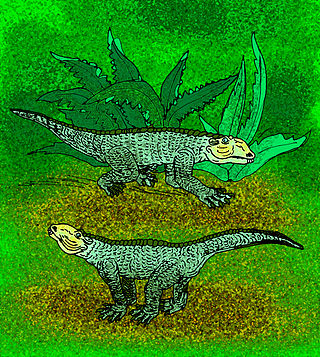
Chimaerasuchus is an extinct genus of Chinese crocodyliform from the Early Cretaceous Wulong Formation. The four teeth in the very tip of its short snout gave it a "bucktoothed" appearance. Due its multicusped teeth and marked heterodonty, it is believed to have been an herbivore. Chimaerasuchus was originally discovered in the 1960s but not identified as a crocodyliform until 1995, instead thought to possibly be a multituberculate mammal. It is highly unusual, as only two other crocodyliforms have displayed any characteristics resembling its adaptations to herbivory.
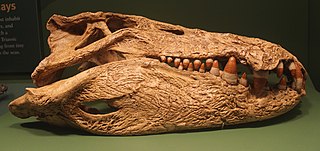
Mahajangasuchus is an extinct genus of crocodyliform which had blunt, conical teeth. The type species, M. insignis, lived during the Late Cretaceous; its fossils have been found in the Maevarano Formation in northern Madagascar. It was a fairly large predator, measuring up to 4 metres (13 ft) long.

Anatosuchus is an extinct genus of notosuchian crocodyliforms discovered in Gadoufaoua, Niger, and described by a team of palaeontologists led by the American Paul Sereno in 2003, in the Journal of Vertebrate Paleontology. Its duck-like snout coincidentally makes it resemble a crocoduck, an imagined hybrid animal with the head of a crocodile and the body of a duck.
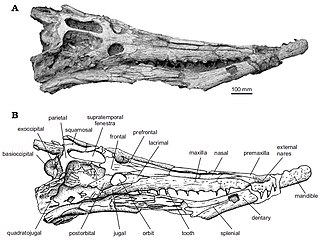
Dyrosauridae is a family of extinct neosuchian crocodyliforms that lived from the Campanian to the Eocene. Dyrosaurid fossils are globally distributed, having been found in Africa, Asia, Europe, North America and South America. Over a dozen species are currently known, varying greatly in overall size and cranial shape. A majority were aquatic, some terrestrial and others fully marine, with species inhabiting both freshwater and marine environments. Ocean-dwelling dyrosaurids were among the few marine reptiles to survive the Cretaceous–Paleogene extinction event.

Araripesuchus is a genus of extinct crocodyliform that existed during the Cretaceous period of the late Mesozoic era some 125 to 66 million years ago. Six species of Araripesuchus are currently known. They are generally considered to be notosuchians, characterized by their varied teeth types and distinct skull elements. This genus consists of six species: A. buitreraensis, discovered in Argentina, A. wegeneri, discovered in Cameroon and Niger, A. rattoides, discovered in Niger, A. tsangatsangana, discovered in Madagascar, A. gomesii, discovered in Brazil and another species discovered in Argentina, A. patagonicus. It has been argued that the phylogenetic position of this genus is uncertain, and that taxonomic revision is required.

Langstonia is an extinct genus of notosuchian crocodylomorph of the family Sebecidae. It lived in the middle Miocene, in the "Monkey Beds" of the Colombian Villavieja Formation. Langstonia was named in 2007 by Alfredo Paolillo and Omar Linares for fossils originally described by Langston in 1965 as Sebecus huilensis. Thus, the type species is L. huilensis.

Asiatosuchus is an extinct genus of crocodyloid crocodilians that lived in Eurasia during the Paleogene. Many Paleogene crocodilians from Europe and Asia have been attributed to Asiatosuchus since the genus was named in 1940. These species have a generalized crocodilian morphology typified by flat, triangular skulls. The feature that traditionally united these species under the genus Asiatosuchus is a broad connection or symphysis between the two halves of the lower jaw. Recent studies of the evolutionary relationships of early crocodilians along with closer examinations of the morphology of fossil specimens suggest that only the first named species of Asiatosuchus, A. grangeri from the Eocene of Mongolia, belongs in the genus. Most species are now regarded as nomina dubia or "dubious names", meaning that their type specimens lack the unique anatomical features necessary to justify their classification as distinct species. Other species such as "A." germanicus and "A." depressifrons are still considered valid species, but they do not form an evolutionary grouping with A. grangeri that would warrant them being placed together in the genus Asiatosuchus.

Eilenodon is an extinct genus of rhynchocephalian reptile from the Late Jurassic Morrison Formation of western North America, present in stratigraphic zone 4. The only known species of this genus is Eilenodon robustus. It was a member of a group of rhynchocephalians called the eilenodontines, which were large, herbivorous members of Rhynchocephalia, the order of reptiles which contains the modern tuatara (Sphenodon). The generic name "Eilenodon" is Greek for "packed teeth", in reference to its closely packed teeth. The specific name, "robustus", refers to the strong build of the jaws.
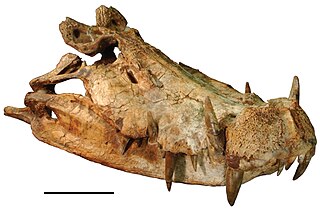
Kaprosuchus is an extinct genus of mahajangasuchid crocodyliform. It is known from a single nearly complete skull collected from the Upper Cretaceous Echkar Formation of Niger. The name means "boar crocodile" from the Greek κάπρος, kapros ("boar") and σοῦχος, soukhos ("crocodile") in reference to its unusually large caniniform teeth which resemble those of a boar. It has been nicknamed "BoarCroc" by Paul Sereno and Hans Larsson, who first described the genus in a monograph published in ZooKeys in 2009 along with other Saharan crocodyliformes such as Anatosuchus and Laganosuchus. The type species is K. saharicus.

Sebecus is an extinct genus of sebecid crocodylomorph from Eocene of South America. Like other sebecosuchians, it was entirely terrestrial and carnivorous. The genus is currently represented by two species, the type S. icaeorhinus and S. ayrampu. Several other species have been referred to Sebecus, but were later reclassified as their own genera.

Platyognathus is an extinct genus of protosuchian crocodyliform. Fossils are known from the Early Jurassic Lower Lufeng Formation in Yunnan, China and belong to the type and only species, P. hsui.
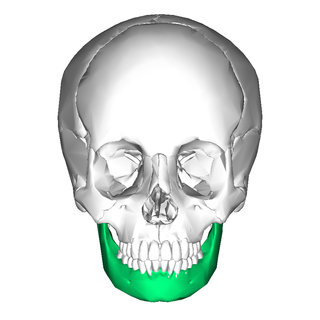
In jawed vertebrates, the mandible, lower jaw, or jawbone is a bone that makes up the lower – and typically more mobile – component of the mouth.

Astorgosuchus is an extinct monospecific genus of crocodilian, closely related to true crocodiles, that lived in Pakistan during the late Oligocene period. This crocodile may have reached lengths of up to 7–8 m (23–26 ft) and is known to have preyed on many of the large mammals found in its environment. Bite marks of a large crocodile have been found on the bones of juvenile Paraceratherium, however if these were left by Astorgosuchus cannot be said with certainty. The genus contains a single species, Astorgosuchus bugtiensis, which was originally named as a species of Crocodylus in 1908 and was moved to its own genus in 2019.

Aymberedactylus is a genus of tapejarid pterosaur from the Early Cretaceous Crato Formation of Brazil. It contains a single species, A. cearensis.
Sabinosuchus is a genus of Mesoeucrocodylian, from the Maastrichtian Escondido Formation of Coahuila, Mexico, with Sabinosuchus coahuilensis as the type species. First described as a putative dyrosaurid by Shiller II et al. (2016), it was later recovered as a pholidosaurid by Jouve & Jalil (2020).

Kansaignathus is an extinct genus of dromaeosaurid theropod from the Late Cretaceous Yalovach Formation of Tajikistan. The genus contains only one species, the type species, K. sogdianus. The generic name of Kansaignathus comes from near the town of Konsoy where it was discovered and the Greek word "gnathos" meaning "jaw". The specific epithet "sogdianus" is derived from the historical region of Sogdiana, which was an ancient name for the Fergana Valley region where the fossil was discovered. Kansaignathus is known from a single right dentary bone and a few post-cranial bone fragments. It was the first, and so far the only, dinosaur from Tajikistan to be described and named.
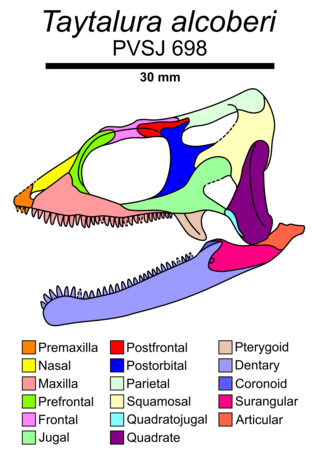
Taytalura is an extinct genus of lepidosauromorph reptile from the Late Triassic of Argentina. It contains a single species, Taytalura alcoberi, which is based on a well-preserved skull from the fossiliferous Ischigualasto Formation. As a lepidosauromorph, Taytalura is a distant relative of modern lepidosaurs such as sphenodontians and squamates. Taytalura did not belong to any group of modern lepidosaurs, since it bears unique features, such as unfused bones in the skull roof and teeth which all sit loosely in a deep groove without sockets. Regardless, Micro-CT scanning reveals features of the skull previously only seen in rhynchocephalians. This suggests that the ancestral condition of the skull in lepidosaurs was more similar to sphenodonts than to squamates.
























